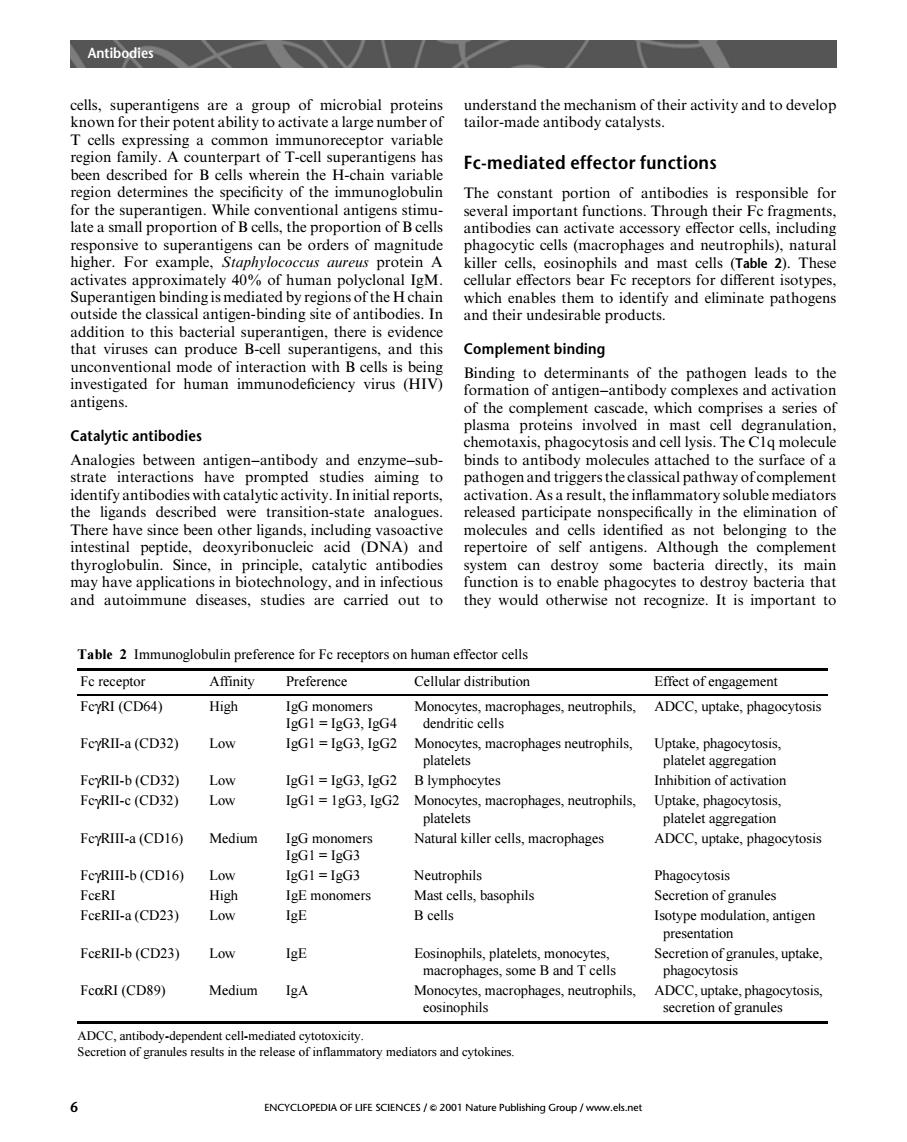正在加载图片...

Antibodies cells.superantigens are a group of microbial proteins understand the mechanism of their activity and to develop known for their potent ability to activate a large number of tailor-made antibody catalysts. cells expressing a common immunoreceptor varabl egio an bed for B Fc-mediated effector functions region determines the specificity of the immunoglobulin The constant portion of antibodies is responsible for for the superantigen.While conventional antigens stimu several important functions.Through their Fe fragments, late a small proportion of B cells.the proportion of Bcells can activate accesory effector cells,including rophages and neutrop activates approximately 40%of human polvclonal IgM. ors for different isotyp which enables them to identify and eliminate pathogens e the and their undesirable products that vir this Complement binding unconventional mode of interaction with B cells is bein investigated for human immunodeficiency virus (HIV) Binding to determinants antigens. f the Catalytic antibodies emotaxis,phagocytosis and cell lysis.The Clq molecule Analogies bet oinds to ant ody mo ched to the surface of tify antibo th t.the infla the ligands described were transition-state analogues. released participate nonspecifically in the elimination of e been othe molecules and cells identified not belonging to the antigens ug om andauiSoaplteat cytes tod mune diseases studies are carried out to they would otherwise not recognize.It is important to Table 2 Immunoglobulin preference for Fe receptors on human effector cells Fe recepto Affinity Preference Cellular distributior Effect of engagement FCYRI (CD64) High IgG monomers Monocytes.macrophages.neutrophils. ADCC,uptake,phagocytosis dendritic cells FeyRII-a(CD32) Low IgG1 =IgG3.IgG2 FcYRII-b(CD32 Low tion of activatio FcyRII-c(CD32) IgGI =IgG3,IgG2 Uptake,phagocytosis FeyRI-a(CDI6) Medium IgG mo ADCC,uptake,phagocytosis FeyRIII-b(CD16) gG1-IgG3 Neutronhils monomer Ma ells,basophils Secretion of FceRII-a(CD23) Low sotype lation,antigen FceRII-b(CD23) Low anules,uptake ma FcoRI(CD89) Medium Mor rophages,neutrophils. ADCC.uptake pha ADCC.antibody-dependent cell-mediated cytotoxicity Secretion of granules results in the relea and ytokine 6 ENCYCLOPEDIA OF LIFE SCIENCES/e2001 Nat Publishing Group/www.els.netcells, superantigens are a group of microbial proteins known for their potent ability to activate a large number of T cells expressing a common immunoreceptor variable region family. A counterpart of T-cell superantigens has been described for B cells wherein the H-chain variable region determines the specificity of the immunoglobulin for the superantigen. While conventional antigens stimulate a small proportion of B cells, the proportion of B cells responsive to superantigens can be orders of magnitude higher. For example, Staphylococcus aureus protein A activates approximately 40% of human polyclonal IgM. Superantigen binding is mediated by regions of the H chain outside the classical antigen-binding site of antibodies. In addition to this bacterial superantigen, there is evidence that viruses can produce B-cell superantigens, and this unconventional mode of interaction with B cells is being investigated for human immunodeficiency virus (HIV) antigens. Catalytic antibodies Analogies between antigen–antibody and enzyme–substrate interactions have prompted studies aiming to identify antibodies with catalytic activity. In initial reports, the ligands described were transition-state analogues. There have since been other ligands, including vasoactive intestinal peptide, deoxyribonucleic acid (DNA) and thyroglobulin. Since, in principle, catalytic antibodies may have applications in biotechnology, and in infectious and autoimmune diseases, studies are carried out to understand the mechanism of their activity and to develop tailor-made antibody catalysts. Fc-mediated effector functions The constant portion of antibodies is responsible for several important functions. Through their Fc fragments, antibodies can activate accessory effector cells, including phagocytic cells (macrophages and neutrophils), natural killer cells, eosinophils and mast cells (Table 2). These cellular effectors bear Fc receptors for different isotypes, which enables them to identify and eliminate pathogens and their undesirable products. Complement binding Binding to determinants of the pathogen leads to the formation of antigen–antibody complexes and activation of the complement cascade, which comprises a series of plasma proteins involved in mast cell degranulation, chemotaxis, phagocytosis and cell lysis. The C1q molecule binds to antibody molecules attached to the surface of a pathogen and triggers the classical pathway of complement activation. As a result, the inflammatory soluble mediators released participate nonspecifically in the elimination of molecules and cells identified as not belonging to the repertoire of self antigens. Although the complement system can destroy some bacteria directly, its main function is to enable phagocytes to destroy bacteria that they would otherwise not recognize. It is important to Table 2 Immunoglobulin preference for Fc receptors on human effector cells ADCC, antibody-dependent cell-mediated cytotoxicity. Secretion of granules results in the release of inflammatory mediators and cytokines. Fc receptor Affinity Preference Cellular distribution Effect of engagement FcγRI (CD64) High IgG monomers IgG1 = IgG3, IgG4 Monocytes, macrophages, neutrophils, dendritic cells ADCC, uptake, phagocytosis FcγRII-a (CD32) Low IgG1 = IgG3, IgG2 Monocytes, macrophages neutrophils, platelets Uptake, phagocytosis, platelet aggregation FcγRII-b (CD32) Low IgG1 = IgG3, IgG2 B lymphocytes Inhibition of activation FcγRII-c (CD32) Low IgG1 = 1gG3, IgG2 Monocytes, macrophages, neutrophils, platelets Uptake, phagocytosis, platelet aggregation FcγRIII-a (CD16) Medium IgG monomers IgG1 = IgG3 Natural killer cells, macrophages ADCC, uptake, phagocytosis FcγRIII-b (CD16) Low IgG1 = IgG3 Neutrophils Phagocytosis FcεRI High IgE monomers Mast cells, basophils Secretion of granules FcεRII-a (CD23) Low IgE B cells Isotype modulation, antigen presentation FcεRII-b (CD23) Low IgE Eosinophils, platelets, monocytes, macrophages, some B and T cells Secretion of granules, uptake, phagocytosis FcαRI (CD89) Medium IgA Monocytes, macrophages, neutrophils, eosinophils ADCC, uptake, phagocytosis, secretion of granules Antibodies 6 ENCYCLOPEDIA OF LIFE SCIENCES / & 2001 Nature Publishing Group / www.els.net